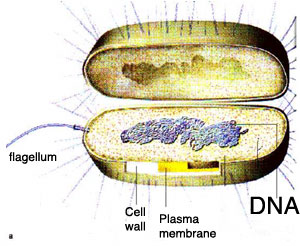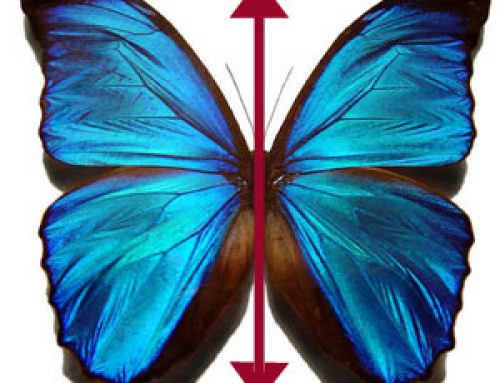
A prokaryote (seen through a microscope)
What does “prokaryote” mean?
The simplest living cells are called prokaryotes, which is Greek for “before the nucleus” – these are cells that were so simple that they didn’t have a nucleus.
When did the first prokaryotes evolve?
The first prokaryotes probably evolved from even simpler cells about 3.5 billion years ago, during the Archaean Eon. For at least a billion years, prokaryotes were the only living things on Earth.
What was Earth like during the Archaean Eon?
What were those simpler cells like?
How many prokaryotes are there on Earth?
Most of the living things on Earth are still prokaryotes, and still reproduce in the same way. All bacteria are simple cells like this, and there are far more bacteria in the world than there are other kinds of living things. There are about five nonillion bacteria on Earth, or 5,000,000,000,000,000,000,000,000,000,000 bacteria. But there are also other kinds of simple cells too.
Many prokaryotes live inside people
A few of these bacteria live in or on people – you yourself have about ten times as many bacteria in and on you as you do human cells. You have about 1000 trillion (1,000,000,000,000,000) bacteria living on you (more, when you are sick).
But still only about one in every million bacteria in the world lives on a person. One very common kind of bacteria is called E.coli.
What do E. coli bacteria do?
 What’s inside a prokaryote cell?
What’s inside a prokaryote cell?
Even prokaryotes (pro-KAR-ee-ot-eez) are more complicated than just a lipid membrane and some DNA.
Prokaryotes have both DNA and RNA inside the cell wall or membrane. The DNA unzips to make a molecule of RNA, and then the RNA makes proteins that help rebuild the cell wall. Sometimes the DNA reproduces itself, and then the new DNA molecule clings to the cell wall while the cell divides to make a new cell with the new DNA inside it.
Prokaryote cells also have a little string of protein molecules that hangs off the end like a tail, called a flagellum. The cell can move this flagellum by pushing protons or energy at it, and it can use the flagellum to move itself from one place to another.
How do prokaryote cells get energy?
Like other living things, prokaryote cells need energy for all this unzipping and building and dividing. The earliest prokaryotes got their energy by letting enzymes take apart molecules of various things and letting out some of the electrons that held that molecule together.
The early prokaryotes broke apart a lot of different kinds of molecules for energy. Some of them broke apart hydrogen or sulfur molecules. Others broke apart amino acids.
What’s an amino acid?
What’s an enzyme?
Photosynthesis and prokaryote cells
About three billion years ago, some of the prokaryotes evolved to be able to pull electrons out of the sunlight that fell on them from space, in a process called photosynthesis. All prokaryotes can also get rid of the leftover molecules and atoms they don’t want anymore by pushing them back out through the cell wall.
About two billion years ago, a few of the early prokaryotes evolved into more complicated cells called eukaryotes, which are the ancestors of plants and animals and mushrooms and algae.
Learn by doing – making yogurt
Eukaryotes
Bibliography and further reading about prokaryotes:




